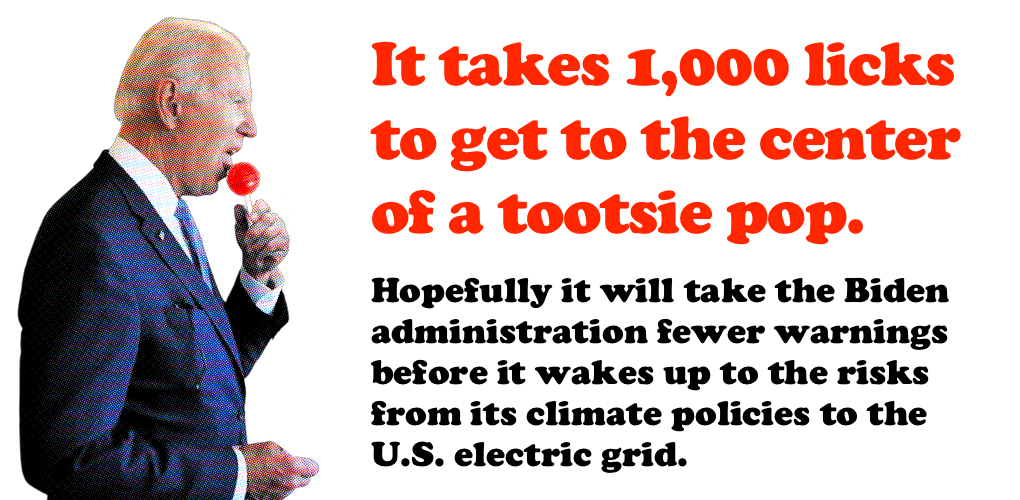
The Senate Takes Measure of the Reliability Crisis
The Wall Street Journal asked in a recent editorial, “How many warnings does it take before the Biden Administration wakes up to the risks from its climate policies to the U.S. electric grid?”
Here’s hoping it’s less than the number of licks it takes to get to the center of a tootsie pop—mathematicians at New York University found it’s 1,000. For the grid reliability experts at the North American Electric Reliability Corporation (NERC), it may feel like they’re approaching that number. And they’re going to get another shot at it tomorrow when NERC’s CEO Jim Robb, along with several other expert witnesses, testifies on grid reliability issues in front of the Senate Energy and Natural Resources Committee.
The Energy and Natural Resources Committee recently heard from the Federal Energy Regulatory Commission about the grave concerns it has for how the energy transition is being handled, or, rather, mishandled. Senators kept hearing the word “crisis” again and again. Even FERC Chairman Willie Phillips, appointed by President Biden, said, “I am extremely concerned about the pace of retirements we are seeing of generators which are needed for reliability on our system. NERC and the grid operators have warned us about this.”
Now Jim Robb is going to address NERC’s summer reliability assessment that found two-thirds of the country is at high risk of blackouts should widespread heatwaves push peak demand beyond available supply. The regions facing the threat of power shortages include large portions of the West, Texas, the Midwest, the Southeast and New England—a total area that includes 160 million Americans.
“The system is closer to the edge,” said John Moura, NERC director of reliability assessment and performance analysis, responding to the release of the assessment. He added, “We certainly don’t want to see many [fossil units] coming off at once. The systems simply cannot be changed overnight.”
Well, surprise…
The Biden EPA Doubles Down
While the nation’s grid reliability and resource adequacy go from bad to frightening, with a broken record of warnings about a baseload retirement crisis stretching back nearly a decade, the Biden administration has decided not to fix the problem but rather add fuel to the fire.
The U.S. Environmental Protection Agency’s (EPA) blitz of rulemakings – including its recently proposed climate rule – will be the elephant in the room tomorrow. As EPA administrator Michael Regan has boasted, he’s using the agency’s full suite of authorities to accelerate plant retirements. In other words, a lot of plants will be coming off at once.
While there is understandable focus on EPA’s climate rule, and its unworkable and unlawful mandates for fuel switching and the implementation of technology that isn’t close to adequately demonstrated and commercially viable, it’s the accumulation of other rules that will do – and are already doing – so much damage to resource adequacy in the near-term. The climate rule is designed to wipe out what’s left of the coal fleet after the rest of the regulatory wave has done the heavy lifting.
According to a new Sierra Club report, just two rules, out of the six EPA is using to pressure the coal fleet, will require 64% of coal plants to make upgrades to address traditional emissions from their facilities. Of those, 53% would have to install various types of pollution control technology and another 11% would have to upgrade existing controls. Faced with a still mounting wave of rulemakings, utilities are likely to close plants to comply, precisely what the grid can ill-afford.
As PJM, the operator of the nation’s largest grid, recently found, it’s going to be short of capacity in just a few years as retirements far outpace the speed at which new, reliable capacity is coming online. PJM expects 25 GW of capacity to be pushed off the grid due to policy, namely EPA regulation and state-mandated clean energy targets. PJM believes just three EPA rulemakings – not including the newly proposed climate rule – could force 10,500 MW of capacity off the grid by 2030.
The Biden administration must wake up to the crisis it’s creating. Warning after warning has made it clear the danger we’re in and the polices driving it. It shouldn’t take cascading blackouts to force a policy change but we’re well on our way to the middle of this tootsie pop. It’s now up to Congress to listen to the experts and respond with desperately needed legislative proposals that hold EPA accountable and ensure it’s actually coordinating with FERC, NERC and the grid operators, not ignoring them.
- On May 31, 2023
